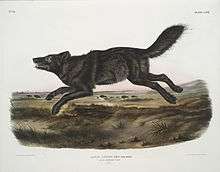Florida black wolf
The Florida black wolf (Canis lupus floridanus),[2][3] also known as the Florida wolf and the black wolf,[4] is an extinct subspecies of Canis lupus[2] that lived in Florida. This subspecies became extinct in 1908 due to crowding out of its habitat and hunting.[5]
| Florida black wolf | |
|---|---|
 | |
| A Florida black wolf as drawn by James Audubon in Viviparous Quadrupeds of North America | |
Extinct (1908) | |
| Scientific classification | |
| Kingdom: | Animalia |
| Phylum: | Chordata |
| Class: | Mammalia |
| Order: | Carnivora |
| Family: | Canidae |
| Genus: | Canis |
| Species: | C. lupus |
| Subspecies: | †C. l. floridanus |
| Trinomial name | |
| Canis lupus floridanus Miller, 1912[1] | |
| Synonyms[2] | |
|
Canis floridanus (Miller, 1912)[1] | |
Species controversy
This wolf is recognized as a subspecies of Canis lupus in the taxonomic authority Mammal Species of the World (2005).[2]
At one time this canid was proposed by some authors as a subspecies of the red wolf - the red wolf once lived primarily in Texas - [6]and that a variation in the red wolf's coloring led to the creation of the Florida black wolf.[7] A red-colored species, known as the Florida red wolf, once resided in Florida as well, though it also became extinct in 1921.[5] It was believed by one author that both species, instead of being subspecies of the red wolf, were actually a type of coyote, which led to the change in the trinomial name to Canis niger niger.[8]
References
- Miller, Proc. Biol. Soc. Washington, vol. 25, p. 95, May 4, 1912
- Wozencraft, W.C. (2005). "Order Carnivora". In Wilson, D.E.; Reeder, D.M (eds.). Mammal Species of the World: A Taxonomic and Geographic Reference (3rd ed.). Johns Hopkins University Press. pp. 575–577. ISBN 978-0-8018-8221-0. OCLC 62265494. url=https://books.google.com/books?id=JgAMbNSt8ikC&pg=PA576
- Canis lupus floridanus, Catalogue of Life
- Murray Wrobel (2007). Elsevier's Dictionary of Mammals: In Latin, English, German, French and Italian. Elsevier. pp. 72–. ISBN 978-0-444-51877-4.
- there have been many sightings of large canines in Florida they could just be escaped pets turned feral. "For saving the Florida panther, it's desperation time" – St. Petersburg Times. Pqasb.pqarchiver.com (1990-02-11). Retrieved on 2012-12-30.
- "BREVARD COUNTY, FLORIDA: A Short History to 1955" – Google Docs. Docs.google.com. Retrieved on 2012-12-30.
- Lois Denny (2004). Alsatian Shepalute's: A New Breed For A New Millennium. AuthorHouse. pp. 42–. ISBN 978-1-4184-3922-4.
- Jay H. Lehr; Janet K. Lehr (2000). Std Hndbk Env. Health, Sci. McGraw Hill Professional. pp. 6–. ISBN 978-0-07-038309-8.
External links
- Tiffin Shewmake (2002). Canine Courage. PageFree Publishing, Inc. pp. 33–. ISBN 978-1-930252-89-9.